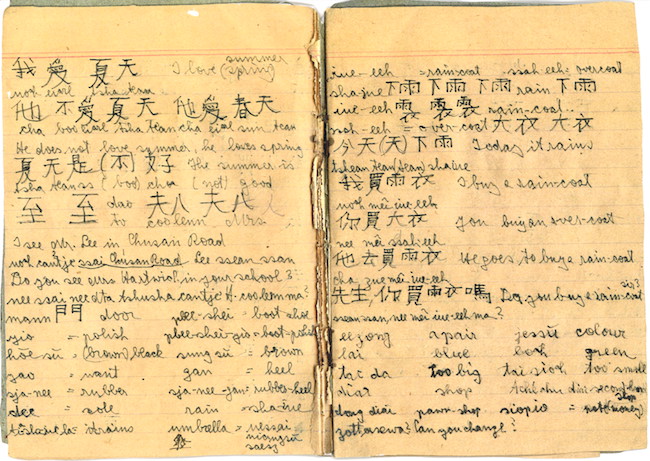Docent Training Materials
Richard's test event
Here are the direct links (for email marketing):
Add event to calendar
Here is the button (for the website )
St. Louis and Danish Boat Photos
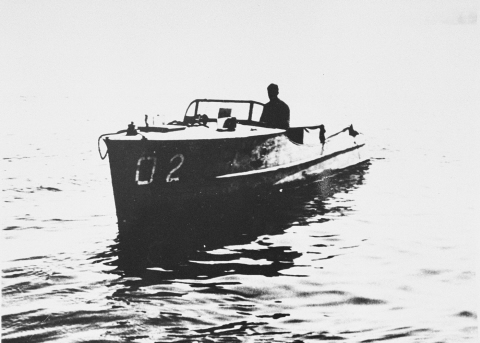
Danish fishing boat used for the rescue of Jews during the occupation of Denmark, now on display at the United States Holocaust Memorial Museum
In 1943, three years after the German occupation of Denmark, the Nazis decided to deport all Jews from the Scandinavian nation. In response, Danish fisherman began to ferry Jews to neutral Sweden in their boats, assisted by ordinary citizens and the Danish police and government. Over 7,700 people were saved.
Denmark (USHMM)
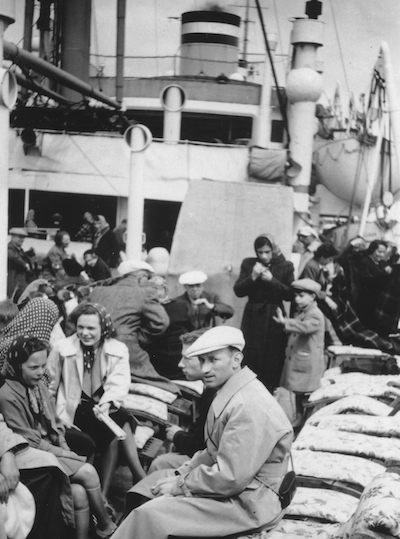
Passengers on the Deck of the St. Louis, 1939
In 1939 a group of German Jews left Hamburg, Germany for Cuba aboard the luxury ocean liner St. Louis. Upon arrival, however, the entrance visas of all but 28 passengers were rejected, and the rest were forced to return to Europe, where they eventually were accepted by France, England, Belgium, and The Netherlands. As the war progressed, only those who ended up in England found relative safety, as the Nazi army spread through the rest of mainland Europe.
Boy Scout Membership Card and School Notebook
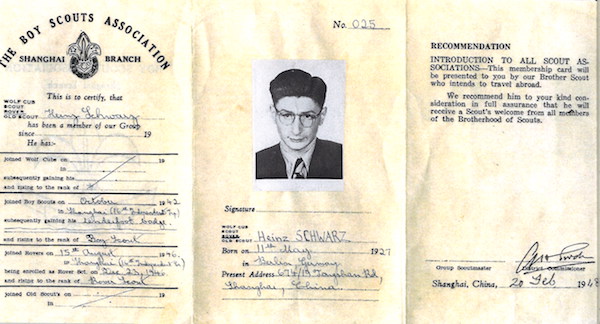
In April of 1939, Heinz Schwarz’s father purchased passage for the family to Shanghai, China, one of the few places that offered an escape for Jews. Heinz turned 12 during the two month journey. They arrived to find cramped quarters and unsanitary living conditions. A Jewish ghetto emerged in Shanghai. Life was challenging for Jews in Shanghai, but Heinz joined the Boy Scouts, went to school, and participated in social events. Since his family did not know where they would live after the war, Heinz learned English, French, Chinese, and Japanese along with his native German. At the end of World War II five years later, they tried to contact their relatives who had stayed behind in Germany only to find that all had been killed in the Holocaust. In 1948, the family immigrated to the United States and settled in Seattle.
Additional Resources
German and Austrian Jewish Refugees in Shanghai (USHMM)
Exit Visas - Docent Training
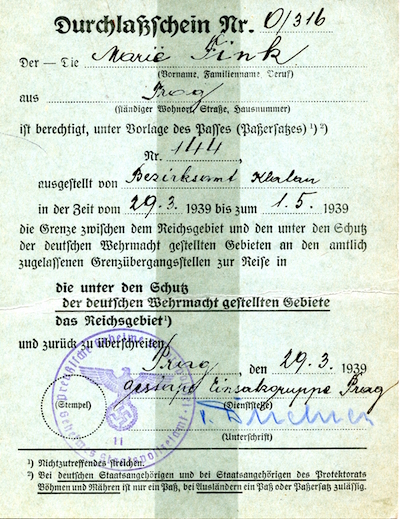
Marie "Mizzi" Fink – Born Marie Siller in 1909 in Eisenstein, Germany
- Moved to Prague, Czechoslovakia at age 14, would visit sister studying in Karlsbad where she met Karl Fink, married in 1936
- Nazis invaded Sudetenland (which included Eisenstein and Karlsbad) in 1938, then Prague in 1939 where Mizzi and Karl were
- Karl waited in line for days to get exit visas, which allowed them to escape in 1939 to Holland and on to England the last day they could enter the UK without entrance visas
- Immigrated to America in 1942
When the Nazis invaded Czechoslovakia in 1939, Karl Fink waited in line for days to obtain exit visas for himself and his wife, Mizzi. Upon receiving them on March 29th, 1939, the young couple fled that day for England. Though unknown at the time, the Finks arrived in the United Kingdom on the last day immigrants were allowed to enter without an entrance visa, April 1st, 1939.
From Mizzi's story:
March 15, l939 was the fateful day! In the early hours in the morning, the Radio Prague announced that Adolf Hitler was at the Czech borders and was marching towards Prague. This was the worst news we could imagine. We were so naive and dumb; we did not think this would ever happen! It was a terrible blow. People were screaming and crying. It was the saddest day imaginable. A few hours later, the tanks were rolling. The Germans were marching down Václaskě Náměsty–Prague's main square. It was a dark day. Streetlights were on - people were marching and crying - an unforgettable day. I too watched there.
There was no time to lose. We knew that we had better leave because conditions to leave would get more and more difficult. The Nazis required you to have documents to leave one's country, which were most difficult to get, and without them, one could not leave. So everybody (the Jews, who wanted to get out of the country) naturally tried to obtain these documents and waited in line for hours, days; so did Karl. We decided that we would leave at once as soon as Karl obtained the two cards (permission) to leave from the Gestapo. I knew that I had better be packed and ready to say good-bye to my parents and friends...the hardest thing to do. We packed and all. We also found out that passengers to England still did not require a visa until April 1st. The train would go through Nazi Germany. What a decision to leave one's country, family and friends---everything!
This was the great chance! Oh please let's not miss it. "Please Gestapo; give us the #Nr01315 and #Nr01306 DURCHLASS-SCHEIN." (These were the train numbers and lines) Karl and I were so lucky! We obtained these blue cards issued on March 29th 1939! We were able to leave the same day and hopefully, save our lives. Unfortunately, friends, who fled to the woods to escape, got shot and killed. Only a few people could leave–not my parents, relatives, etc. We parted at the railway station crying; knowing we might not see each other anymore.
We went with the next train to England on March 30th. Visas were still not required until April 1st 1939. Each of us was allowed one suitcase plus RM 10.00 (Equivalent of $5 to $10 today). Many people could not decide whether to leave and wanted to come later. Had my parents gotten on the train instead of waiting in Prague, they could have saved their lives. I could never get over it. I was never able to get over it. I will never forget it! It was the Masaryk Railway Station. We discovered that this train was full of Jewish refugees like us. So again, I had to part with my parents' relatives and friends who came to this train. It was terribly emotional!
After a while riding on the train, two Gestapo officers entered and demanded our passports. When Karl handed them both to them, one of the officers looked quite a while at mine, and then he looked at me and screamed, "ich hätte gute lust sie zu-rück zu schicken (I would like to send you back!)." I started to cry. We pleaded with him. It was terrible. Finally, after some anxious moments with him, he threw the passport back at me. All of us, including the other passengers in the compartment were relieved. The train went through Nazi Germany. It stopped several times at gasoline stations. Sometimes, we all had to leave the train with our suitcases for inspections. Everybody had to carry his or her suitcase to be examined. Some passengers were stripped naked, suspected for smuggling something. Luckily, we did not have to undress and they left us alone.
Additional Resources
German Jewish Refugees 1933-1939 (USHMM)
Add event to calendar
Cigarette Cards
Battle of the Third Reich
The tradition of collectable cards sold in cigarette cartons dates back to 1895, but World War II marked a renaissance for the medium. These cards, manufactured in Dresden and Berlin by the Cigarettenfabrik Constantin, advertise a new start for the country using the slogan "Germany Awakens." Popular among young Germans who had grown up impoverished post World War I, the cards were manufactured limited edition sets which could be pasted into an album for safekeeping.
Ironically, the cards were printed despite the Nazi's rabid anti-smoking campaign. Hitler was the driving force behind the program, believing that by smoking, the "master race" was jeopardizing their genetic superiority. By the early 40s, smoking on public transportation and in bomb shelters was widely illegal. Women, especially pregnant women, were the targets of the harshest anti -smoking propaganda. Soon, restrictions on tobacco advertising were created, banning cigarette ads in rural areas, on train lines, and in race tracks. Furthermore, portraying smoking as a masculine virtue (akin to the American "Marlboro Man") was forbidden.
However, the Nazi war on tobacco was full of contradictions. Soldiers were still rationed cigarettes, and Nazi Party magazines featured pictures of models smoking. By 1941, tobacco was taxed at near 90% of retail price and accounted for 12% of government revenue.
Perhaps in an effort to both appease Hitler and boost sales in the face of the public's new wariness of tobacco, cigarette companies revived the tradition of trading cards. The tinted photographs and illustrations transitioned from images of the Berlin Olympics, screen actors and animals to become more focused on depicting Nazi propaganda.
Nuremberg Rallies 1923
Held in September of 1923, "The German Day Rally" was a meeting and parade of the nationalist parties of Germany. It acted as a model for future Nuremberg Rallies that would be held by the Nazis annually until World War II. Nuremberg was chosen for its idyllic Bavarian location and because the local Nazi leader there, Julius Streicher, was a trusted colleague of Hitler's. Streicher can be seen in standing next to Hitler in card 16.
The Nuremberg rallies grew in importance over the years, eventually lasting for a week and attracting half a million people. The rallies were perfect opportunities to flaunt the new Germany's military might and compel her citizens to blindly support the Nazi cause. Adolph Hitler and other top officials attended the anticipated event without fail. Every year, the rally had a theme and each year a speech was made to celebrate the theme. Oftentimes, a similarly themed propaganda film would be filmed at the rally.
Reichstag Fire
The dark colors of this card convey the gravity of the event it depicts; the arson of the German parliament, or Reichstag. Lit only by the sinister flames that engulf the grand building, the card expresses the Nazi attitude towards the fire.
On February 27th, 1933, the Berlin's Reichstag building was burned was destroyed in an arson fire. To this day, the origins of the fire are unclear, but the Nazis blamed communists and exploited the event to win approval for an emergency "Decree of the People and the State" issued by then President Paul von Hindenburg. The so-called "Reichstag Decree" eliminated freedom of speech, freedom of the press and right to assembly and granted absolute power to the Nazi coalition government under Adolf Hitler. A few months later, the Nazis would overthrow the German state governments, establish the first concentration camp, and grant absolute power to Chancellor Adolf Hitler. Only a week later, the first official boycott of Jewish goods was implemented.
The Brown House, Munich
If not for the menacing Nazi flag, the so-called "Brown House" would look like an affluent urban home. In fact, that's what it was until Elizabeth Barlow, an English widow, sold the "Barlow Palace" to the growing Nazi Party in 1930. It was then converted into an office building and opened as the head quarter of the Nazi Party in 1931. The Brown House contained Hitler's main office, which featured a life size portrait of Hitler's idol, Henry Ford. The Party's Supreme Court and the Reich Press Office were also located in the house.
The Brown house was virtually destroyed during the Allied bombings of the 40s, and the rubble was cleared in 1951. The lot remained empty until 2008, when construction began on a new museum dedicated to teaching and remembering the city's political past. The Munich Documentation Centre for the History of National Socialism is slated to open in April 2015.

